Relationship Between Employee Engagement and Tesco's Performance
VerifiedAdded on 2023/01/17
|11
|3455
|24
Report
AI Summary
This report analyzes the relationship between employee engagement and Tesco's performance. It begins with an overview of Tesco, highlighting its business operations and the importance of employee engagement. The literature review explores the concept of employee engagement, examining various models and factors influencing it, such as organizational culture, leadership, and rewards. The report investigates the impact of employee engagement on business performance, including productivity, profitability, and customer satisfaction. It also discusses strategies for improving employee engagement, such as two-way communication. Secondary resources like academic books, journals, and industry reports were used to conduct the study. The report concludes with a summary of key findings and recommendations for Tesco to enhance employee engagement and improve overall business outcomes. The study emphasizes the significance of employee engagement for human resource professionals and its implications on business success.

Applied Business Research
Paraphrase This Document
Need a fresh take? Get an instant paraphrase of this document with our AI Paraphraser
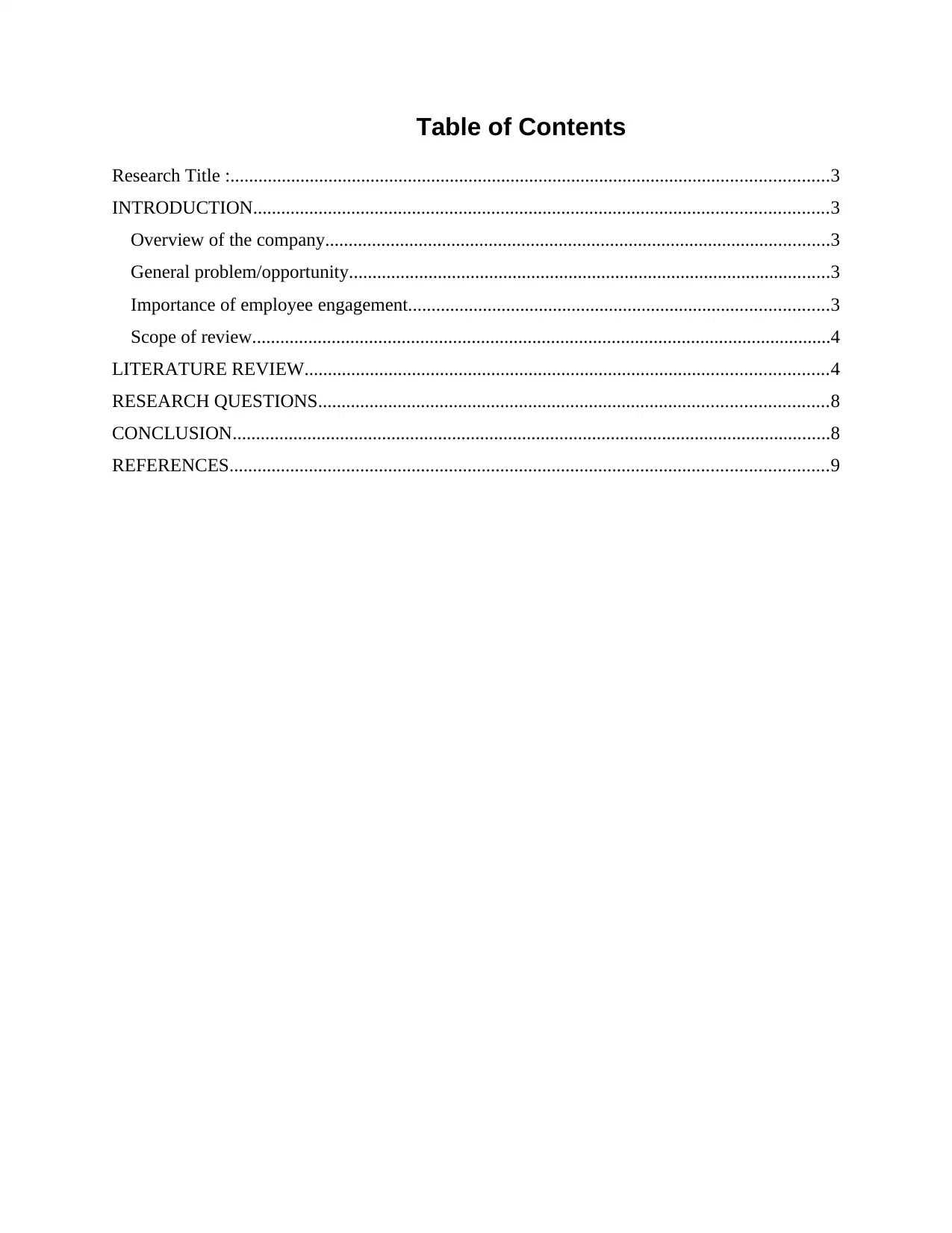
Table of Contents
Research Title :................................................................................................................................3
INTRODUCTION...........................................................................................................................3
Overview of the company............................................................................................................3
General problem/opportunity.......................................................................................................3
Importance of employee engagement..........................................................................................3
Scope of review............................................................................................................................4
LITERATURE REVIEW................................................................................................................4
RESEARCH QUESTIONS.............................................................................................................8
CONCLUSION................................................................................................................................8
REFERENCES................................................................................................................................9
Research Title :................................................................................................................................3
INTRODUCTION...........................................................................................................................3
Overview of the company............................................................................................................3
General problem/opportunity.......................................................................................................3
Importance of employee engagement..........................................................................................3
Scope of review............................................................................................................................4
LITERATURE REVIEW................................................................................................................4
RESEARCH QUESTIONS.............................................................................................................8
CONCLUSION................................................................................................................................8
REFERENCES................................................................................................................................9
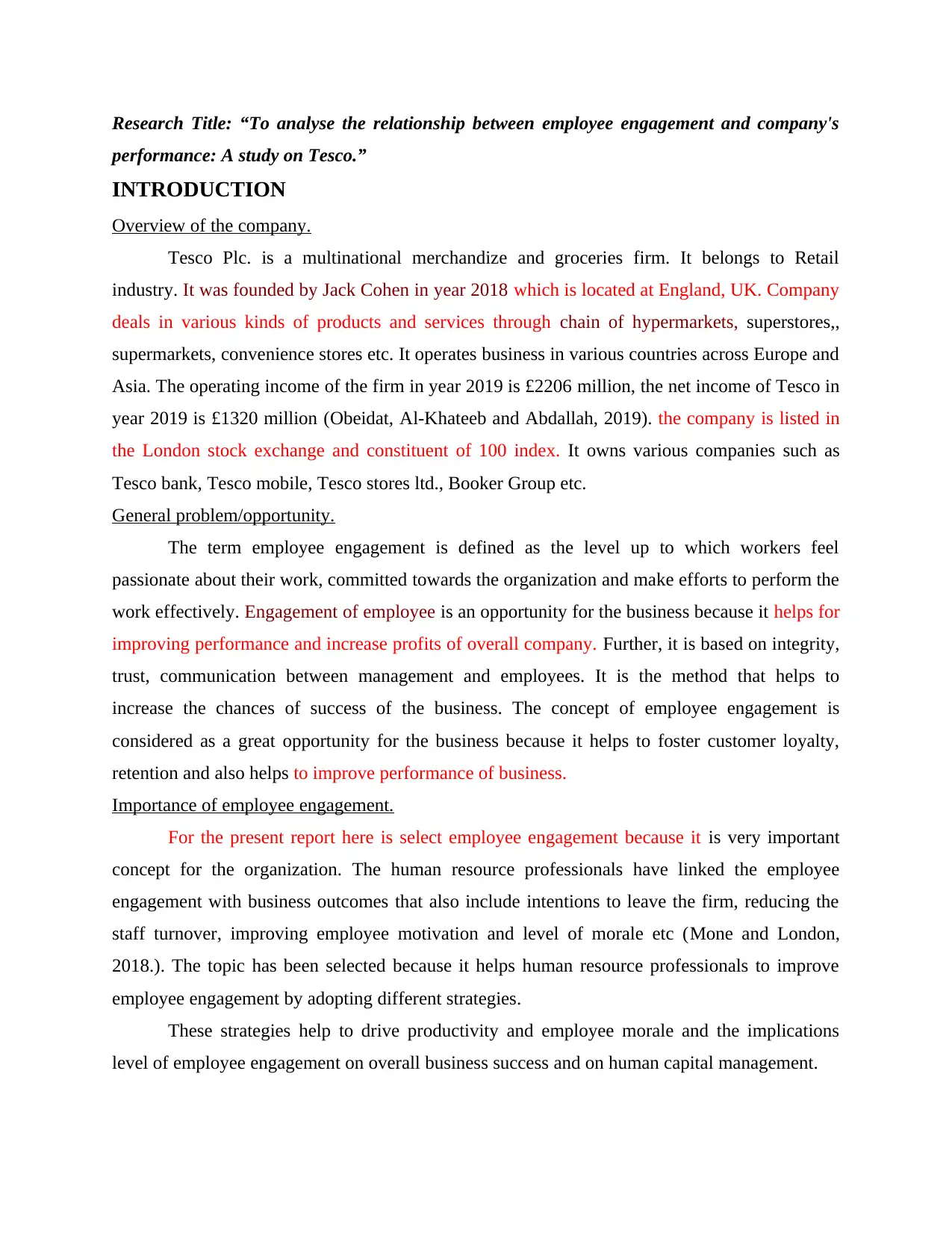
Research Title: “To analyse the relationship between employee engagement and company's
performance: A study on Tesco.”
INTRODUCTION
Overview of the company.
Tesco Plc. is a multinational merchandize and groceries firm. It belongs to Retail
industry. It was founded by Jack Cohen in year 2018 which is located at England, UK. Company
deals in various kinds of products and services through chain of hypermarkets, superstores,,
supermarkets, convenience stores etc. It operates business in various countries across Europe and
Asia. The operating income of the firm in year 2019 is £2206 million, the net income of Tesco in
year 2019 is £1320 million (Obeidat, Al-Khateeb and Abdallah, 2019). the company is listed in
the London stock exchange and constituent of 100 index. It owns various companies such as
Tesco bank, Tesco mobile, Tesco stores ltd., Booker Group etc.
General problem/opportunity.
The term employee engagement is defined as the level up to which workers feel
passionate about their work, committed towards the organization and make efforts to perform the
work effectively. Engagement of employee is an opportunity for the business because it helps for
improving performance and increase profits of overall company. Further, it is based on integrity,
trust, communication between management and employees. It is the method that helps to
increase the chances of success of the business. The concept of employee engagement is
considered as a great opportunity for the business because it helps to foster customer loyalty,
retention and also helps to improve performance of business.
Importance of employee engagement.
For the present report here is select employee engagement because it is very important
concept for the organization. The human resource professionals have linked the employee
engagement with business outcomes that also include intentions to leave the firm, reducing the
staff turnover, improving employee motivation and level of morale etc (Mone and London,
2018.). The topic has been selected because it helps human resource professionals to improve
employee engagement by adopting different strategies.
These strategies help to drive productivity and employee morale and the implications
level of employee engagement on overall business success and on human capital management.
performance: A study on Tesco.”
INTRODUCTION
Overview of the company.
Tesco Plc. is a multinational merchandize and groceries firm. It belongs to Retail
industry. It was founded by Jack Cohen in year 2018 which is located at England, UK. Company
deals in various kinds of products and services through chain of hypermarkets, superstores,,
supermarkets, convenience stores etc. It operates business in various countries across Europe and
Asia. The operating income of the firm in year 2019 is £2206 million, the net income of Tesco in
year 2019 is £1320 million (Obeidat, Al-Khateeb and Abdallah, 2019). the company is listed in
the London stock exchange and constituent of 100 index. It owns various companies such as
Tesco bank, Tesco mobile, Tesco stores ltd., Booker Group etc.
General problem/opportunity.
The term employee engagement is defined as the level up to which workers feel
passionate about their work, committed towards the organization and make efforts to perform the
work effectively. Engagement of employee is an opportunity for the business because it helps for
improving performance and increase profits of overall company. Further, it is based on integrity,
trust, communication between management and employees. It is the method that helps to
increase the chances of success of the business. The concept of employee engagement is
considered as a great opportunity for the business because it helps to foster customer loyalty,
retention and also helps to improve performance of business.
Importance of employee engagement.
For the present report here is select employee engagement because it is very important
concept for the organization. The human resource professionals have linked the employee
engagement with business outcomes that also include intentions to leave the firm, reducing the
staff turnover, improving employee motivation and level of morale etc (Mone and London,
2018.). The topic has been selected because it helps human resource professionals to improve
employee engagement by adopting different strategies.
These strategies help to drive productivity and employee morale and the implications
level of employee engagement on overall business success and on human capital management.
⊘ This is a preview!⊘
Do you want full access?
Subscribe today to unlock all pages.

Trusted by 1+ million students worldwide
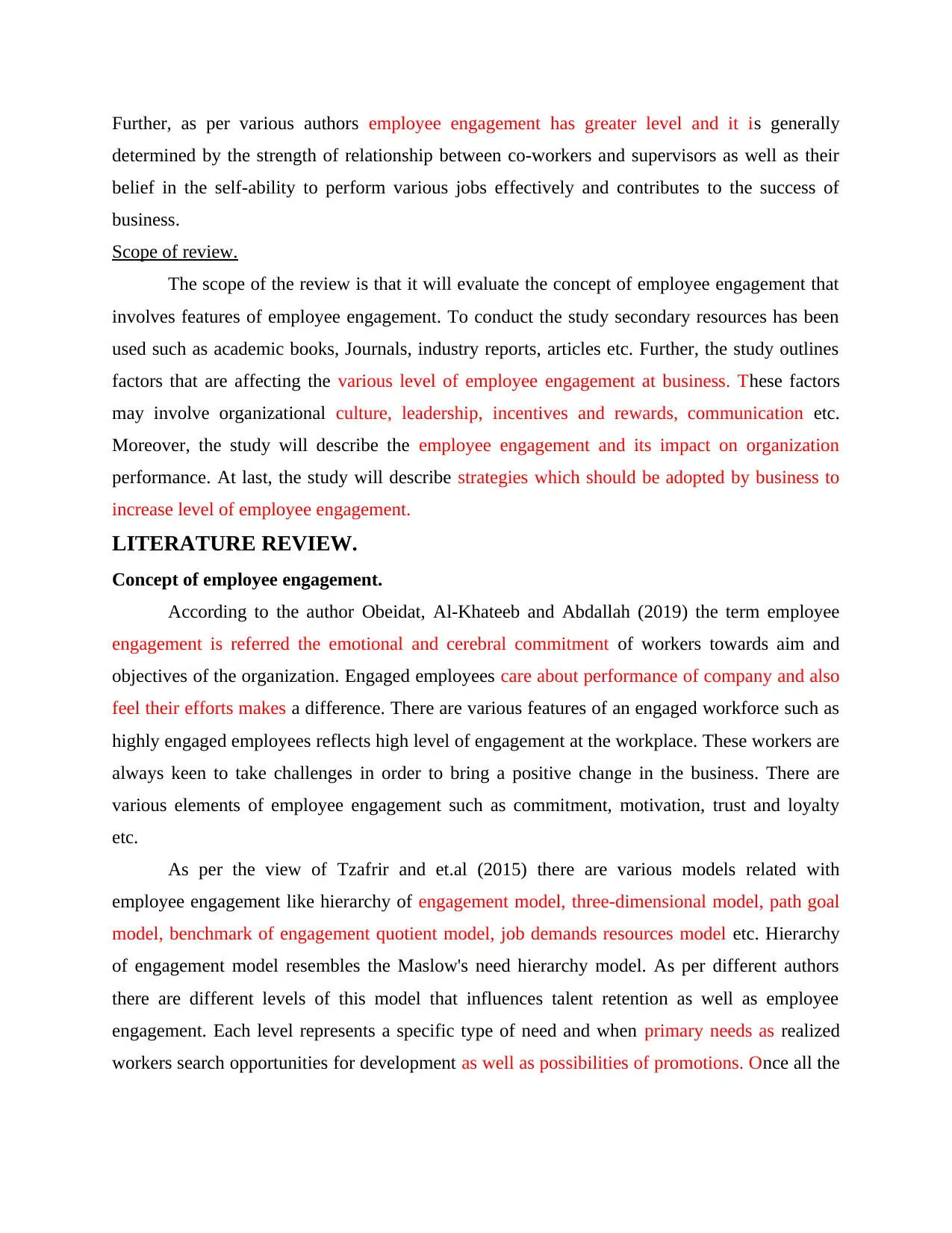
Further, as per various authors employee engagement has greater level and it is generally
determined by the strength of relationship between co-workers and supervisors as well as their
belief in the self-ability to perform various jobs effectively and contributes to the success of
business.
Scope of review.
The scope of the review is that it will evaluate the concept of employee engagement that
involves features of employee engagement. To conduct the study secondary resources has been
used such as academic books, Journals, industry reports, articles etc. Further, the study outlines
factors that are affecting the various level of employee engagement at business. These factors
may involve organizational culture, leadership, incentives and rewards, communication etc.
Moreover, the study will describe the employee engagement and its impact on organization
performance. At last, the study will describe strategies which should be adopted by business to
increase level of employee engagement.
LITERATURE REVIEW.
Concept of employee engagement.
According to the author Obeidat, Al-Khateeb and Abdallah (2019) the term employee
engagement is referred the emotional and cerebral commitment of workers towards aim and
objectives of the organization. Engaged employees care about performance of company and also
feel their efforts makes a difference. There are various features of an engaged workforce such as
highly engaged employees reflects high level of engagement at the workplace. These workers are
always keen to take challenges in order to bring a positive change in the business. There are
various elements of employee engagement such as commitment, motivation, trust and loyalty
etc.
As per the view of Tzafrir and et.al (2015) there are various models related with
employee engagement like hierarchy of engagement model, three-dimensional model, path goal
model, benchmark of engagement quotient model, job demands resources model etc. Hierarchy
of engagement model resembles the Maslow's need hierarchy model. As per different authors
there are different levels of this model that influences talent retention as well as employee
engagement. Each level represents a specific type of need and when primary needs as realized
workers search opportunities for development as well as possibilities of promotions. Once all the
determined by the strength of relationship between co-workers and supervisors as well as their
belief in the self-ability to perform various jobs effectively and contributes to the success of
business.
Scope of review.
The scope of the review is that it will evaluate the concept of employee engagement that
involves features of employee engagement. To conduct the study secondary resources has been
used such as academic books, Journals, industry reports, articles etc. Further, the study outlines
factors that are affecting the various level of employee engagement at business. These factors
may involve organizational culture, leadership, incentives and rewards, communication etc.
Moreover, the study will describe the employee engagement and its impact on organization
performance. At last, the study will describe strategies which should be adopted by business to
increase level of employee engagement.
LITERATURE REVIEW.
Concept of employee engagement.
According to the author Obeidat, Al-Khateeb and Abdallah (2019) the term employee
engagement is referred the emotional and cerebral commitment of workers towards aim and
objectives of the organization. Engaged employees care about performance of company and also
feel their efforts makes a difference. There are various features of an engaged workforce such as
highly engaged employees reflects high level of engagement at the workplace. These workers are
always keen to take challenges in order to bring a positive change in the business. There are
various elements of employee engagement such as commitment, motivation, trust and loyalty
etc.
As per the view of Tzafrir and et.al (2015) there are various models related with
employee engagement like hierarchy of engagement model, three-dimensional model, path goal
model, benchmark of engagement quotient model, job demands resources model etc. Hierarchy
of engagement model resembles the Maslow's need hierarchy model. As per different authors
there are different levels of this model that influences talent retention as well as employee
engagement. Each level represents a specific type of need and when primary needs as realized
workers search opportunities for development as well as possibilities of promotions. Once all the
Paraphrase This Document
Need a fresh take? Get an instant paraphrase of this document with our AI Paraphraser
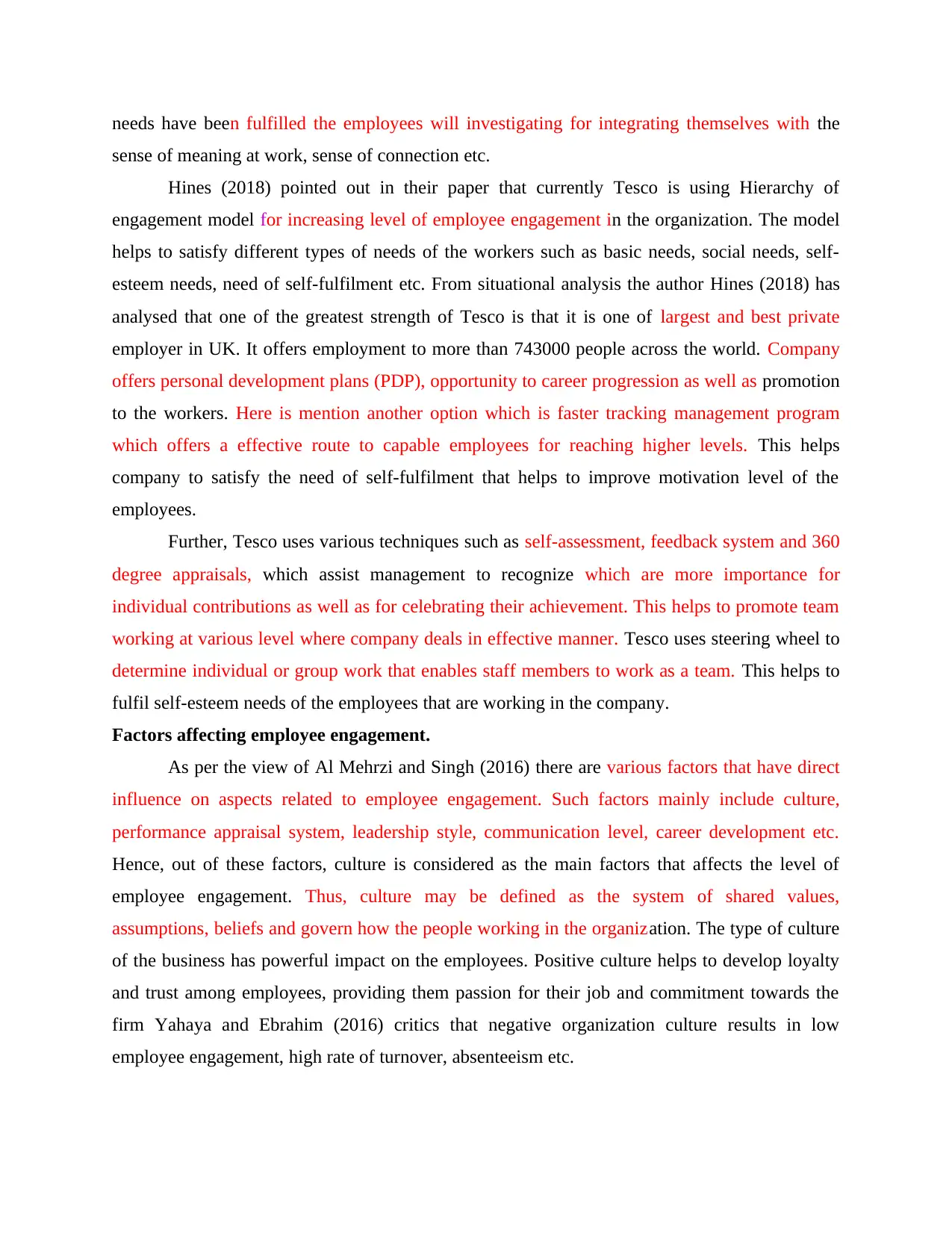
needs have been fulfilled the employees will investigating for integrating themselves with the
sense of meaning at work, sense of connection etc.
Hines (2018) pointed out in their paper that currently Tesco is using Hierarchy of
engagement model for increasing level of employee engagement in the organization. The model
helps to satisfy different types of needs of the workers such as basic needs, social needs, self-
esteem needs, need of self-fulfilment etc. From situational analysis the author Hines (2018) has
analysed that one of the greatest strength of Tesco is that it is one of largest and best private
employer in UK. It offers employment to more than 743000 people across the world. Company
offers personal development plans (PDP), opportunity to career progression as well as promotion
to the workers. Here is mention another option which is faster tracking management program
which offers a effective route to capable employees for reaching higher levels. This helps
company to satisfy the need of self-fulfilment that helps to improve motivation level of the
employees.
Further, Tesco uses various techniques such as self-assessment, feedback system and 360
degree appraisals, which assist management to recognize which are more importance for
individual contributions as well as for celebrating their achievement. This helps to promote team
working at various level where company deals in effective manner. Tesco uses steering wheel to
determine individual or group work that enables staff members to work as a team. This helps to
fulfil self-esteem needs of the employees that are working in the company.
Factors affecting employee engagement.
As per the view of Al Mehrzi and Singh (2016) there are various factors that have direct
influence on aspects related to employee engagement. Such factors mainly include culture,
performance appraisal system, leadership style, communication level, career development etc.
Hence, out of these factors, culture is considered as the main factors that affects the level of
employee engagement. Thus, culture may be defined as the system of shared values,
assumptions, beliefs and govern how the people working in the organization. The type of culture
of the business has powerful impact on the employees. Positive culture helps to develop loyalty
and trust among employees, providing them passion for their job and commitment towards the
firm Yahaya and Ebrahim (2016) critics that negative organization culture results in low
employee engagement, high rate of turnover, absenteeism etc.
sense of meaning at work, sense of connection etc.
Hines (2018) pointed out in their paper that currently Tesco is using Hierarchy of
engagement model for increasing level of employee engagement in the organization. The model
helps to satisfy different types of needs of the workers such as basic needs, social needs, self-
esteem needs, need of self-fulfilment etc. From situational analysis the author Hines (2018) has
analysed that one of the greatest strength of Tesco is that it is one of largest and best private
employer in UK. It offers employment to more than 743000 people across the world. Company
offers personal development plans (PDP), opportunity to career progression as well as promotion
to the workers. Here is mention another option which is faster tracking management program
which offers a effective route to capable employees for reaching higher levels. This helps
company to satisfy the need of self-fulfilment that helps to improve motivation level of the
employees.
Further, Tesco uses various techniques such as self-assessment, feedback system and 360
degree appraisals, which assist management to recognize which are more importance for
individual contributions as well as for celebrating their achievement. This helps to promote team
working at various level where company deals in effective manner. Tesco uses steering wheel to
determine individual or group work that enables staff members to work as a team. This helps to
fulfil self-esteem needs of the employees that are working in the company.
Factors affecting employee engagement.
As per the view of Al Mehrzi and Singh (2016) there are various factors that have direct
influence on aspects related to employee engagement. Such factors mainly include culture,
performance appraisal system, leadership style, communication level, career development etc.
Hence, out of these factors, culture is considered as the main factors that affects the level of
employee engagement. Thus, culture may be defined as the system of shared values,
assumptions, beliefs and govern how the people working in the organization. The type of culture
of the business has powerful impact on the employees. Positive culture helps to develop loyalty
and trust among employees, providing them passion for their job and commitment towards the
firm Yahaya and Ebrahim (2016) critics that negative organization culture results in low
employee engagement, high rate of turnover, absenteeism etc.
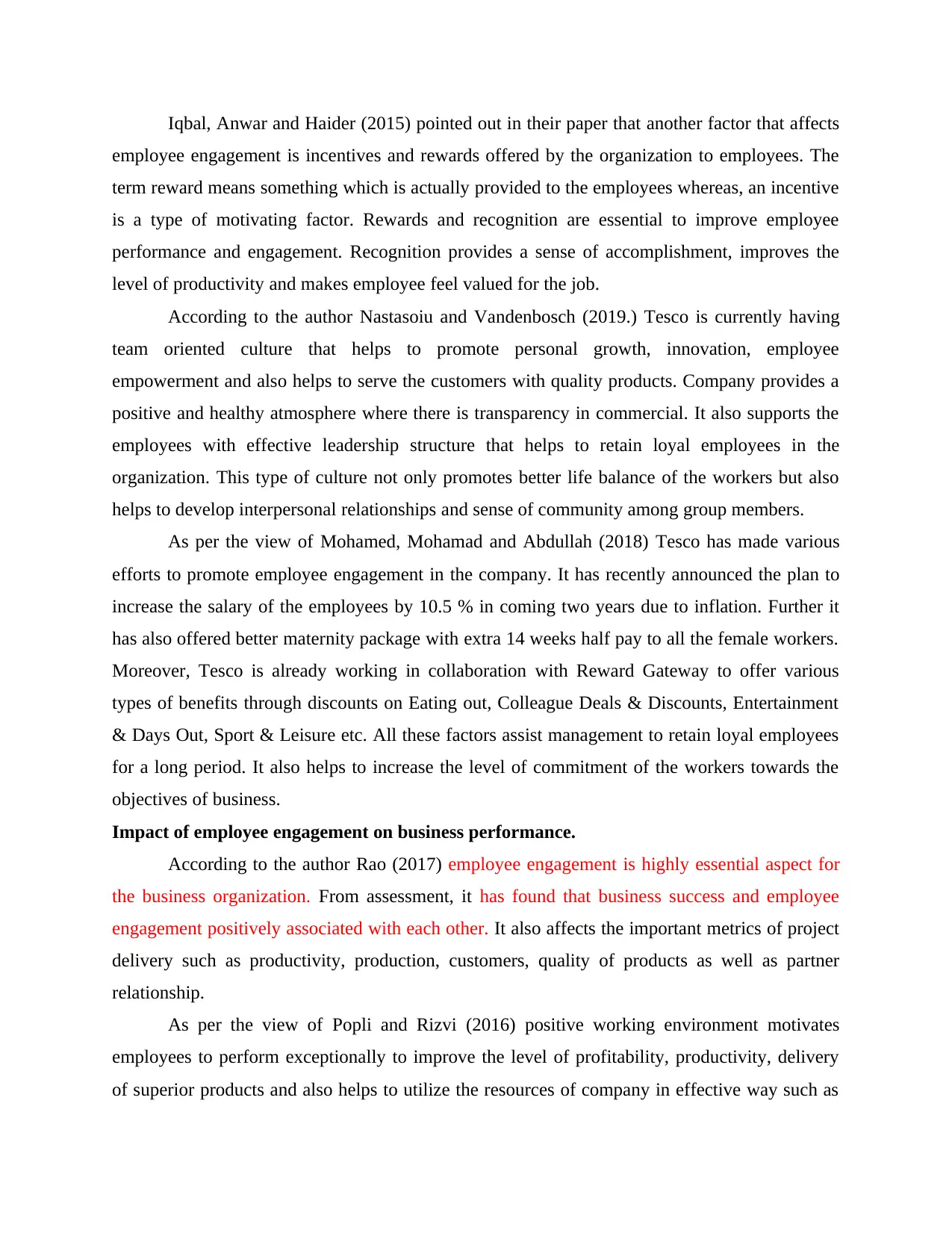
Iqbal, Anwar and Haider (2015) pointed out in their paper that another factor that affects
employee engagement is incentives and rewards offered by the organization to employees. The
term reward means something which is actually provided to the employees whereas, an incentive
is a type of motivating factor. Rewards and recognition are essential to improve employee
performance and engagement. Recognition provides a sense of accomplishment, improves the
level of productivity and makes employee feel valued for the job.
According to the author Nastasoiu and Vandenbosch (2019.) Tesco is currently having
team oriented culture that helps to promote personal growth, innovation, employee
empowerment and also helps to serve the customers with quality products. Company provides a
positive and healthy atmosphere where there is transparency in commercial. It also supports the
employees with effective leadership structure that helps to retain loyal employees in the
organization. This type of culture not only promotes better life balance of the workers but also
helps to develop interpersonal relationships and sense of community among group members.
As per the view of Mohamed, Mohamad and Abdullah (2018) Tesco has made various
efforts to promote employee engagement in the company. It has recently announced the plan to
increase the salary of the employees by 10.5 % in coming two years due to inflation. Further it
has also offered better maternity package with extra 14 weeks half pay to all the female workers.
Moreover, Tesco is already working in collaboration with Reward Gateway to offer various
types of benefits through discounts on Eating out, Colleague Deals & Discounts, Entertainment
& Days Out, Sport & Leisure etc. All these factors assist management to retain loyal employees
for a long period. It also helps to increase the level of commitment of the workers towards the
objectives of business.
Impact of employee engagement on business performance.
According to the author Rao (2017) employee engagement is highly essential aspect for
the business organization. From assessment, it has found that business success and employee
engagement positively associated with each other. It also affects the important metrics of project
delivery such as productivity, production, customers, quality of products as well as partner
relationship.
As per the view of Popli and Rizvi (2016) positive working environment motivates
employees to perform exceptionally to improve the level of profitability, productivity, delivery
of superior products and also helps to utilize the resources of company in effective way such as
employee engagement is incentives and rewards offered by the organization to employees. The
term reward means something which is actually provided to the employees whereas, an incentive
is a type of motivating factor. Rewards and recognition are essential to improve employee
performance and engagement. Recognition provides a sense of accomplishment, improves the
level of productivity and makes employee feel valued for the job.
According to the author Nastasoiu and Vandenbosch (2019.) Tesco is currently having
team oriented culture that helps to promote personal growth, innovation, employee
empowerment and also helps to serve the customers with quality products. Company provides a
positive and healthy atmosphere where there is transparency in commercial. It also supports the
employees with effective leadership structure that helps to retain loyal employees in the
organization. This type of culture not only promotes better life balance of the workers but also
helps to develop interpersonal relationships and sense of community among group members.
As per the view of Mohamed, Mohamad and Abdullah (2018) Tesco has made various
efforts to promote employee engagement in the company. It has recently announced the plan to
increase the salary of the employees by 10.5 % in coming two years due to inflation. Further it
has also offered better maternity package with extra 14 weeks half pay to all the female workers.
Moreover, Tesco is already working in collaboration with Reward Gateway to offer various
types of benefits through discounts on Eating out, Colleague Deals & Discounts, Entertainment
& Days Out, Sport & Leisure etc. All these factors assist management to retain loyal employees
for a long period. It also helps to increase the level of commitment of the workers towards the
objectives of business.
Impact of employee engagement on business performance.
According to the author Rao (2017) employee engagement is highly essential aspect for
the business organization. From assessment, it has found that business success and employee
engagement positively associated with each other. It also affects the important metrics of project
delivery such as productivity, production, customers, quality of products as well as partner
relationship.
As per the view of Popli and Rizvi (2016) positive working environment motivates
employees to perform exceptionally to improve the level of profitability, productivity, delivery
of superior products and also helps to utilize the resources of company in effective way such as
⊘ This is a preview!⊘
Do you want full access?
Subscribe today to unlock all pages.

Trusted by 1+ million students worldwide
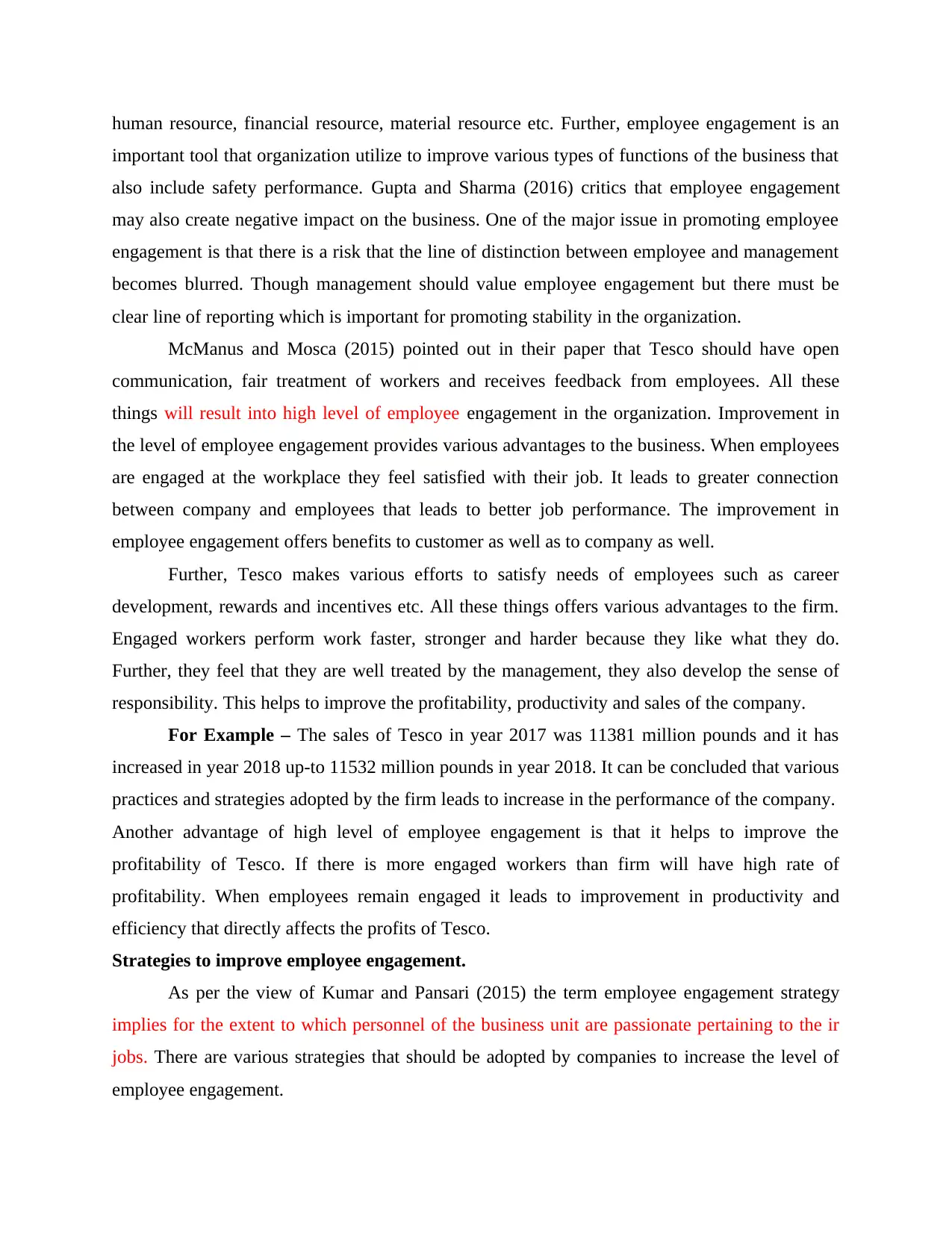
human resource, financial resource, material resource etc. Further, employee engagement is an
important tool that organization utilize to improve various types of functions of the business that
also include safety performance. Gupta and Sharma (2016) critics that employee engagement
may also create negative impact on the business. One of the major issue in promoting employee
engagement is that there is a risk that the line of distinction between employee and management
becomes blurred. Though management should value employee engagement but there must be
clear line of reporting which is important for promoting stability in the organization.
McManus and Mosca (2015) pointed out in their paper that Tesco should have open
communication, fair treatment of workers and receives feedback from employees. All these
things will result into high level of employee engagement in the organization. Improvement in
the level of employee engagement provides various advantages to the business. When employees
are engaged at the workplace they feel satisfied with their job. It leads to greater connection
between company and employees that leads to better job performance. The improvement in
employee engagement offers benefits to customer as well as to company as well.
Further, Tesco makes various efforts to satisfy needs of employees such as career
development, rewards and incentives etc. All these things offers various advantages to the firm.
Engaged workers perform work faster, stronger and harder because they like what they do.
Further, they feel that they are well treated by the management, they also develop the sense of
responsibility. This helps to improve the profitability, productivity and sales of the company.
For Example – The sales of Tesco in year 2017 was 11381 million pounds and it has
increased in year 2018 up-to 11532 million pounds in year 2018. It can be concluded that various
practices and strategies adopted by the firm leads to increase in the performance of the company.
Another advantage of high level of employee engagement is that it helps to improve the
profitability of Tesco. If there is more engaged workers than firm will have high rate of
profitability. When employees remain engaged it leads to improvement in productivity and
efficiency that directly affects the profits of Tesco.
Strategies to improve employee engagement.
As per the view of Kumar and Pansari (2015) the term employee engagement strategy
implies for the extent to which personnel of the business unit are passionate pertaining to the ir
jobs. There are various strategies that should be adopted by companies to increase the level of
employee engagement.
important tool that organization utilize to improve various types of functions of the business that
also include safety performance. Gupta and Sharma (2016) critics that employee engagement
may also create negative impact on the business. One of the major issue in promoting employee
engagement is that there is a risk that the line of distinction between employee and management
becomes blurred. Though management should value employee engagement but there must be
clear line of reporting which is important for promoting stability in the organization.
McManus and Mosca (2015) pointed out in their paper that Tesco should have open
communication, fair treatment of workers and receives feedback from employees. All these
things will result into high level of employee engagement in the organization. Improvement in
the level of employee engagement provides various advantages to the business. When employees
are engaged at the workplace they feel satisfied with their job. It leads to greater connection
between company and employees that leads to better job performance. The improvement in
employee engagement offers benefits to customer as well as to company as well.
Further, Tesco makes various efforts to satisfy needs of employees such as career
development, rewards and incentives etc. All these things offers various advantages to the firm.
Engaged workers perform work faster, stronger and harder because they like what they do.
Further, they feel that they are well treated by the management, they also develop the sense of
responsibility. This helps to improve the profitability, productivity and sales of the company.
For Example – The sales of Tesco in year 2017 was 11381 million pounds and it has
increased in year 2018 up-to 11532 million pounds in year 2018. It can be concluded that various
practices and strategies adopted by the firm leads to increase in the performance of the company.
Another advantage of high level of employee engagement is that it helps to improve the
profitability of Tesco. If there is more engaged workers than firm will have high rate of
profitability. When employees remain engaged it leads to improvement in productivity and
efficiency that directly affects the profits of Tesco.
Strategies to improve employee engagement.
As per the view of Kumar and Pansari (2015) the term employee engagement strategy
implies for the extent to which personnel of the business unit are passionate pertaining to the ir
jobs. There are various strategies that should be adopted by companies to increase the level of
employee engagement.
Paraphrase This Document
Need a fresh take? Get an instant paraphrase of this document with our AI Paraphraser
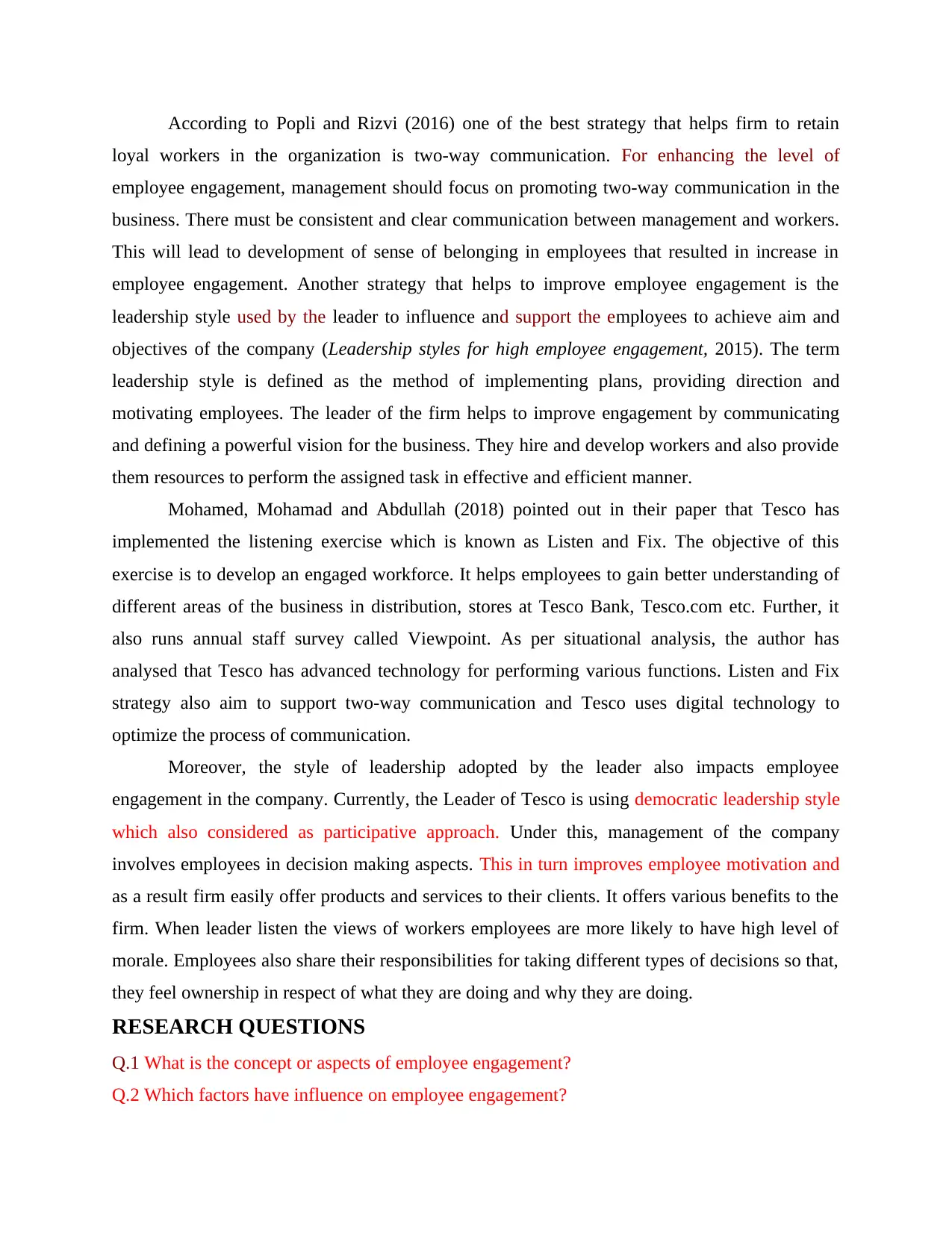
According to Popli and Rizvi (2016) one of the best strategy that helps firm to retain
loyal workers in the organization is two-way communication. For enhancing the level of
employee engagement, management should focus on promoting two-way communication in the
business. There must be consistent and clear communication between management and workers.
This will lead to development of sense of belonging in employees that resulted in increase in
employee engagement. Another strategy that helps to improve employee engagement is the
leadership style used by the leader to influence and support the employees to achieve aim and
objectives of the company (Leadership styles for high employee engagement, 2015). The term
leadership style is defined as the method of implementing plans, providing direction and
motivating employees. The leader of the firm helps to improve engagement by communicating
and defining a powerful vision for the business. They hire and develop workers and also provide
them resources to perform the assigned task in effective and efficient manner.
Mohamed, Mohamad and Abdullah (2018) pointed out in their paper that Tesco has
implemented the listening exercise which is known as Listen and Fix. The objective of this
exercise is to develop an engaged workforce. It helps employees to gain better understanding of
different areas of the business in distribution, stores at Tesco Bank, Tesco.com etc. Further, it
also runs annual staff survey called Viewpoint. As per situational analysis, the author has
analysed that Tesco has advanced technology for performing various functions. Listen and Fix
strategy also aim to support two-way communication and Tesco uses digital technology to
optimize the process of communication.
Moreover, the style of leadership adopted by the leader also impacts employee
engagement in the company. Currently, the Leader of Tesco is using democratic leadership style
which also considered as participative approach. Under this, management of the company
involves employees in decision making aspects. This in turn improves employee motivation and
as a result firm easily offer products and services to their clients. It offers various benefits to the
firm. When leader listen the views of workers employees are more likely to have high level of
morale. Employees also share their responsibilities for taking different types of decisions so that,
they feel ownership in respect of what they are doing and why they are doing.
RESEARCH QUESTIONS
Q.1 What is the concept or aspects of employee engagement?
Q.2 Which factors have influence on employee engagement?
loyal workers in the organization is two-way communication. For enhancing the level of
employee engagement, management should focus on promoting two-way communication in the
business. There must be consistent and clear communication between management and workers.
This will lead to development of sense of belonging in employees that resulted in increase in
employee engagement. Another strategy that helps to improve employee engagement is the
leadership style used by the leader to influence and support the employees to achieve aim and
objectives of the company (Leadership styles for high employee engagement, 2015). The term
leadership style is defined as the method of implementing plans, providing direction and
motivating employees. The leader of the firm helps to improve engagement by communicating
and defining a powerful vision for the business. They hire and develop workers and also provide
them resources to perform the assigned task in effective and efficient manner.
Mohamed, Mohamad and Abdullah (2018) pointed out in their paper that Tesco has
implemented the listening exercise which is known as Listen and Fix. The objective of this
exercise is to develop an engaged workforce. It helps employees to gain better understanding of
different areas of the business in distribution, stores at Tesco Bank, Tesco.com etc. Further, it
also runs annual staff survey called Viewpoint. As per situational analysis, the author has
analysed that Tesco has advanced technology for performing various functions. Listen and Fix
strategy also aim to support two-way communication and Tesco uses digital technology to
optimize the process of communication.
Moreover, the style of leadership adopted by the leader also impacts employee
engagement in the company. Currently, the Leader of Tesco is using democratic leadership style
which also considered as participative approach. Under this, management of the company
involves employees in decision making aspects. This in turn improves employee motivation and
as a result firm easily offer products and services to their clients. It offers various benefits to the
firm. When leader listen the views of workers employees are more likely to have high level of
morale. Employees also share their responsibilities for taking different types of decisions so that,
they feel ownership in respect of what they are doing and why they are doing.
RESEARCH QUESTIONS
Q.1 What is the concept or aspects of employee engagement?
Q.2 Which factors have influence on employee engagement?
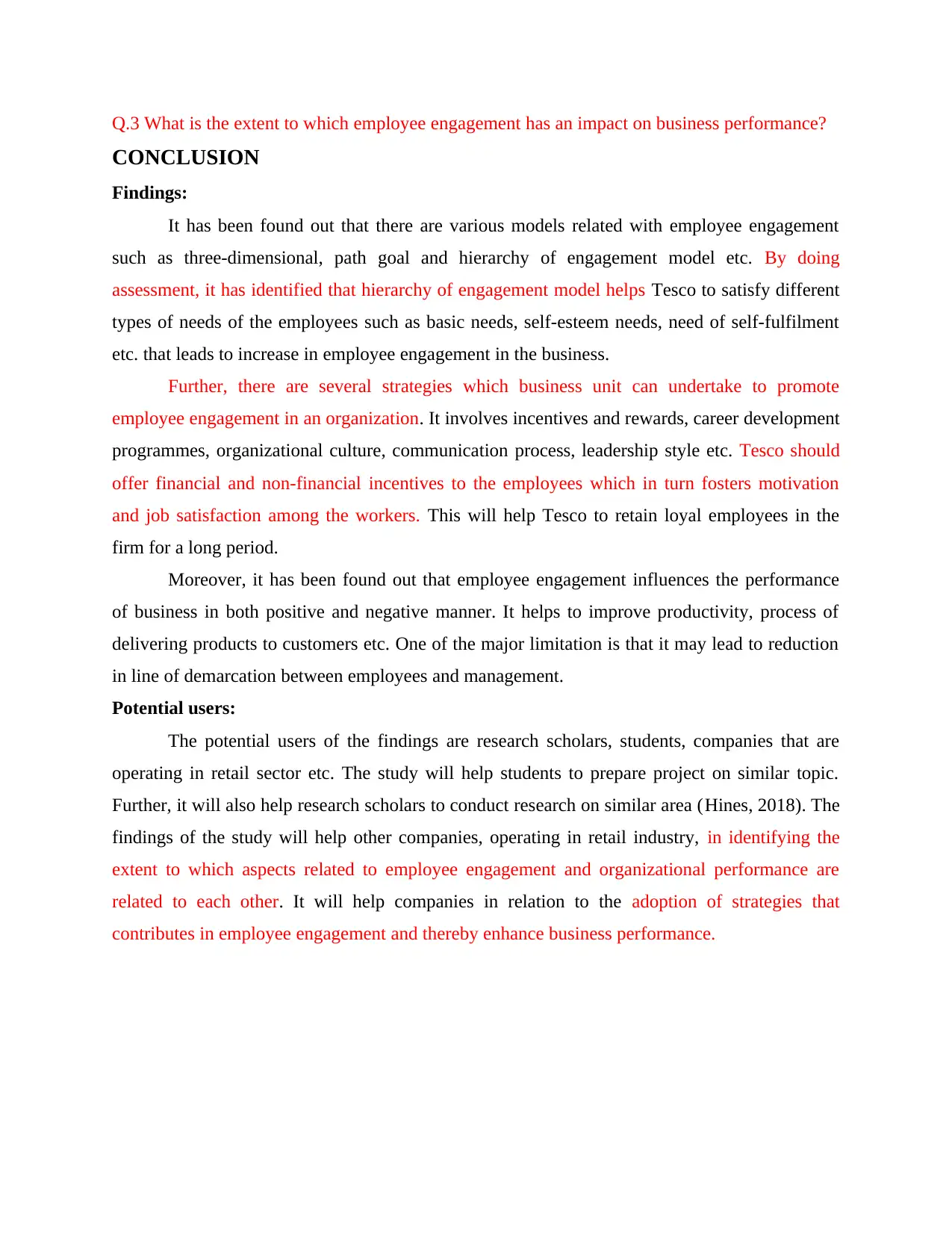
Q.3 What is the extent to which employee engagement has an impact on business performance?
CONCLUSION
Findings:
It has been found out that there are various models related with employee engagement
such as three-dimensional, path goal and hierarchy of engagement model etc. By doing
assessment, it has identified that hierarchy of engagement model helps Tesco to satisfy different
types of needs of the employees such as basic needs, self-esteem needs, need of self-fulfilment
etc. that leads to increase in employee engagement in the business.
Further, there are several strategies which business unit can undertake to promote
employee engagement in an organization. It involves incentives and rewards, career development
programmes, organizational culture, communication process, leadership style etc. Tesco should
offer financial and non-financial incentives to the employees which in turn fosters motivation
and job satisfaction among the workers. This will help Tesco to retain loyal employees in the
firm for a long period.
Moreover, it has been found out that employee engagement influences the performance
of business in both positive and negative manner. It helps to improve productivity, process of
delivering products to customers etc. One of the major limitation is that it may lead to reduction
in line of demarcation between employees and management.
Potential users:
The potential users of the findings are research scholars, students, companies that are
operating in retail sector etc. The study will help students to prepare project on similar topic.
Further, it will also help research scholars to conduct research on similar area (Hines, 2018). The
findings of the study will help other companies, operating in retail industry, in identifying the
extent to which aspects related to employee engagement and organizational performance are
related to each other. It will help companies in relation to the adoption of strategies that
contributes in employee engagement and thereby enhance business performance.
CONCLUSION
Findings:
It has been found out that there are various models related with employee engagement
such as three-dimensional, path goal and hierarchy of engagement model etc. By doing
assessment, it has identified that hierarchy of engagement model helps Tesco to satisfy different
types of needs of the employees such as basic needs, self-esteem needs, need of self-fulfilment
etc. that leads to increase in employee engagement in the business.
Further, there are several strategies which business unit can undertake to promote
employee engagement in an organization. It involves incentives and rewards, career development
programmes, organizational culture, communication process, leadership style etc. Tesco should
offer financial and non-financial incentives to the employees which in turn fosters motivation
and job satisfaction among the workers. This will help Tesco to retain loyal employees in the
firm for a long period.
Moreover, it has been found out that employee engagement influences the performance
of business in both positive and negative manner. It helps to improve productivity, process of
delivering products to customers etc. One of the major limitation is that it may lead to reduction
in line of demarcation between employees and management.
Potential users:
The potential users of the findings are research scholars, students, companies that are
operating in retail sector etc. The study will help students to prepare project on similar topic.
Further, it will also help research scholars to conduct research on similar area (Hines, 2018). The
findings of the study will help other companies, operating in retail industry, in identifying the
extent to which aspects related to employee engagement and organizational performance are
related to each other. It will help companies in relation to the adoption of strategies that
contributes in employee engagement and thereby enhance business performance.
⊘ This is a preview!⊘
Do you want full access?
Subscribe today to unlock all pages.

Trusted by 1+ million students worldwide
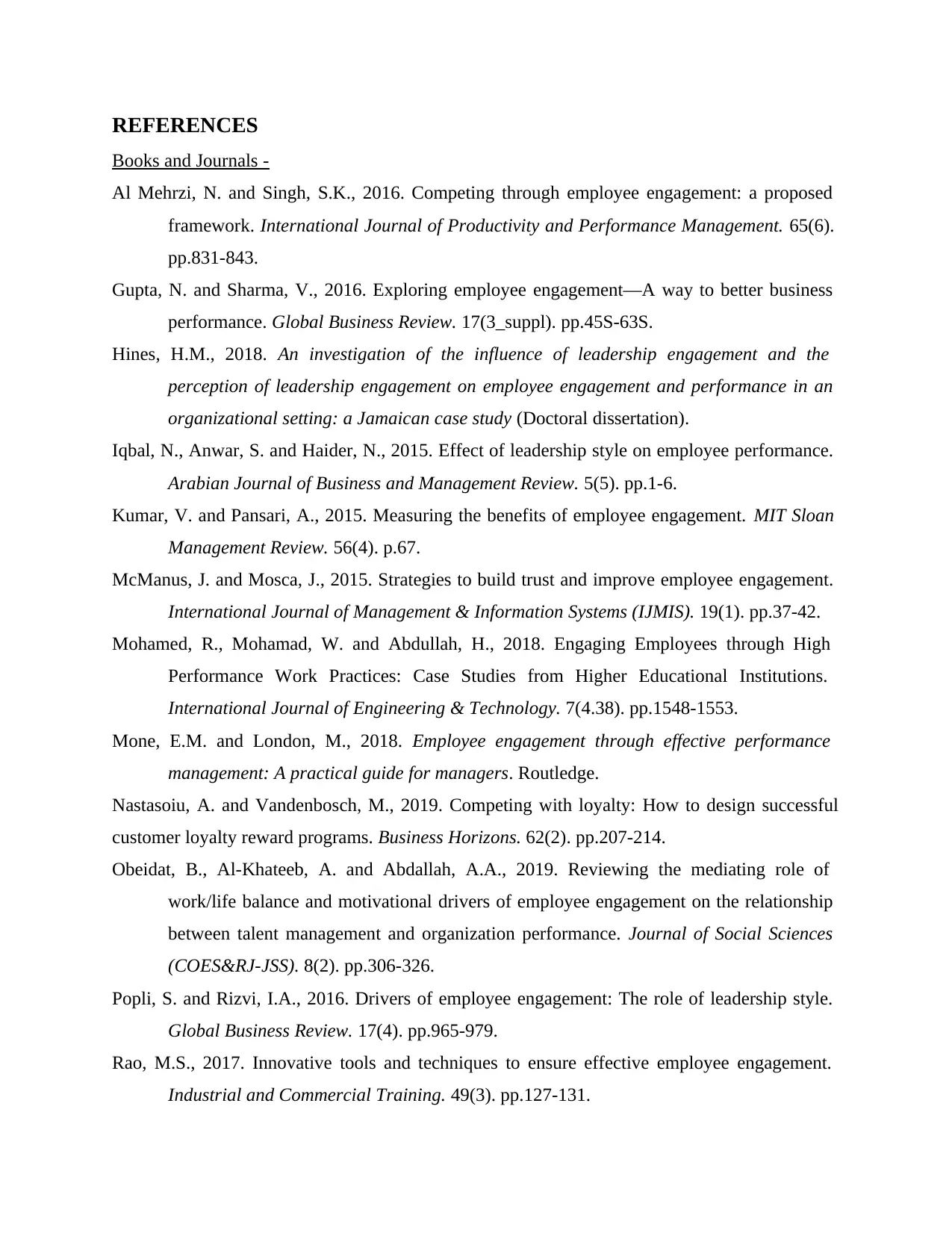
REFERENCES
Books and Journals -
Al Mehrzi, N. and Singh, S.K., 2016. Competing through employee engagement: a proposed
framework. International Journal of Productivity and Performance Management. 65(6).
pp.831-843.
Gupta, N. and Sharma, V., 2016. Exploring employee engagement—A way to better business
performance. Global Business Review. 17(3_suppl). pp.45S-63S.
Hines, H.M., 2018. An investigation of the influence of leadership engagement and the
perception of leadership engagement on employee engagement and performance in an
organizational setting: a Jamaican case study (Doctoral dissertation).
Iqbal, N., Anwar, S. and Haider, N., 2015. Effect of leadership style on employee performance.
Arabian Journal of Business and Management Review. 5(5). pp.1-6.
Kumar, V. and Pansari, A., 2015. Measuring the benefits of employee engagement. MIT Sloan
Management Review. 56(4). p.67.
McManus, J. and Mosca, J., 2015. Strategies to build trust and improve employee engagement.
International Journal of Management & Information Systems (IJMIS). 19(1). pp.37-42.
Mohamed, R., Mohamad, W. and Abdullah, H., 2018. Engaging Employees through High
Performance Work Practices: Case Studies from Higher Educational Institutions.
International Journal of Engineering & Technology. 7(4.38). pp.1548-1553.
Mone, E.M. and London, M., 2018. Employee engagement through effective performance
management: A practical guide for managers. Routledge.
Nastasoiu, A. and Vandenbosch, M., 2019. Competing with loyalty: How to design successful
customer loyalty reward programs. Business Horizons. 62(2). pp.207-214.
Obeidat, B., Al-Khateeb, A. and Abdallah, A.A., 2019. Reviewing the mediating role of
work/life balance and motivational drivers of employee engagement on the relationship
between talent management and organization performance. Journal of Social Sciences
(COES&RJ-JSS). 8(2). pp.306-326.
Popli, S. and Rizvi, I.A., 2016. Drivers of employee engagement: The role of leadership style.
Global Business Review. 17(4). pp.965-979.
Rao, M.S., 2017. Innovative tools and techniques to ensure effective employee engagement.
Industrial and Commercial Training. 49(3). pp.127-131.
Books and Journals -
Al Mehrzi, N. and Singh, S.K., 2016. Competing through employee engagement: a proposed
framework. International Journal of Productivity and Performance Management. 65(6).
pp.831-843.
Gupta, N. and Sharma, V., 2016. Exploring employee engagement—A way to better business
performance. Global Business Review. 17(3_suppl). pp.45S-63S.
Hines, H.M., 2018. An investigation of the influence of leadership engagement and the
perception of leadership engagement on employee engagement and performance in an
organizational setting: a Jamaican case study (Doctoral dissertation).
Iqbal, N., Anwar, S. and Haider, N., 2015. Effect of leadership style on employee performance.
Arabian Journal of Business and Management Review. 5(5). pp.1-6.
Kumar, V. and Pansari, A., 2015. Measuring the benefits of employee engagement. MIT Sloan
Management Review. 56(4). p.67.
McManus, J. and Mosca, J., 2015. Strategies to build trust and improve employee engagement.
International Journal of Management & Information Systems (IJMIS). 19(1). pp.37-42.
Mohamed, R., Mohamad, W. and Abdullah, H., 2018. Engaging Employees through High
Performance Work Practices: Case Studies from Higher Educational Institutions.
International Journal of Engineering & Technology. 7(4.38). pp.1548-1553.
Mone, E.M. and London, M., 2018. Employee engagement through effective performance
management: A practical guide for managers. Routledge.
Nastasoiu, A. and Vandenbosch, M., 2019. Competing with loyalty: How to design successful
customer loyalty reward programs. Business Horizons. 62(2). pp.207-214.
Obeidat, B., Al-Khateeb, A. and Abdallah, A.A., 2019. Reviewing the mediating role of
work/life balance and motivational drivers of employee engagement on the relationship
between talent management and organization performance. Journal of Social Sciences
(COES&RJ-JSS). 8(2). pp.306-326.
Popli, S. and Rizvi, I.A., 2016. Drivers of employee engagement: The role of leadership style.
Global Business Review. 17(4). pp.965-979.
Rao, M.S., 2017. Innovative tools and techniques to ensure effective employee engagement.
Industrial and Commercial Training. 49(3). pp.127-131.
Paraphrase This Document
Need a fresh take? Get an instant paraphrase of this document with our AI Paraphraser
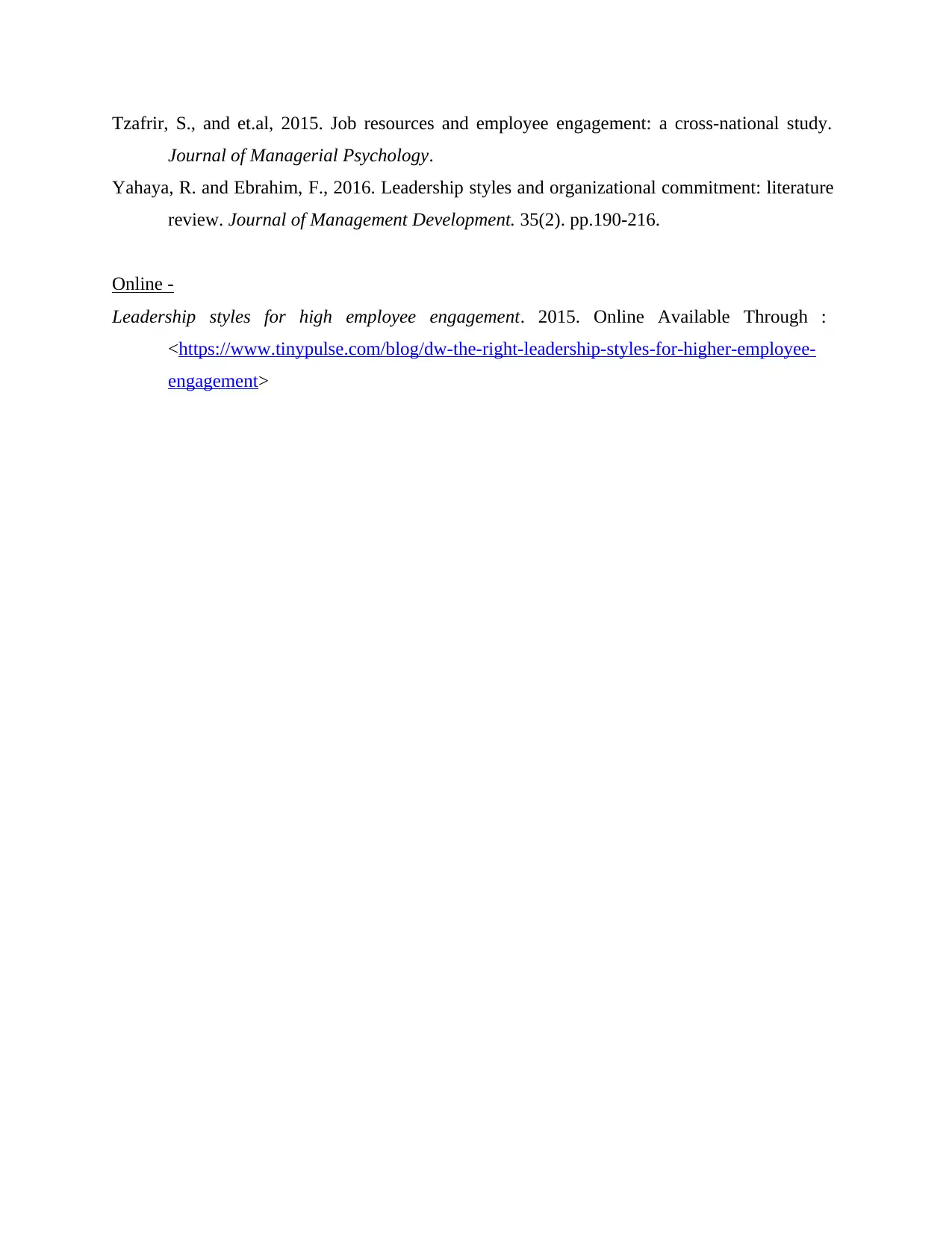
Tzafrir, S., and et.al, 2015. Job resources and employee engagement: a cross-national study.
Journal of Managerial Psychology.
Yahaya, R. and Ebrahim, F., 2016. Leadership styles and organizational commitment: literature
review. Journal of Management Development. 35(2). pp.190-216.
Online -
Leadership styles for high employee engagement. 2015. Online Available Through :
<https://www.tinypulse.com/blog/dw-the-right-leadership-styles-for-higher-employee-
engagement>
Journal of Managerial Psychology.
Yahaya, R. and Ebrahim, F., 2016. Leadership styles and organizational commitment: literature
review. Journal of Management Development. 35(2). pp.190-216.
Online -
Leadership styles for high employee engagement. 2015. Online Available Through :
<https://www.tinypulse.com/blog/dw-the-right-leadership-styles-for-higher-employee-
engagement>
1 out of 11
Related Documents
Your All-in-One AI-Powered Toolkit for Academic Success.
+13062052269
info@desklib.com
Available 24*7 on WhatsApp / Email
![[object Object]](/_next/static/media/star-bottom.7253800d.svg)
Unlock your academic potential
Copyright © 2020–2025 A2Z Services. All Rights Reserved. Developed and managed by ZUCOL.




